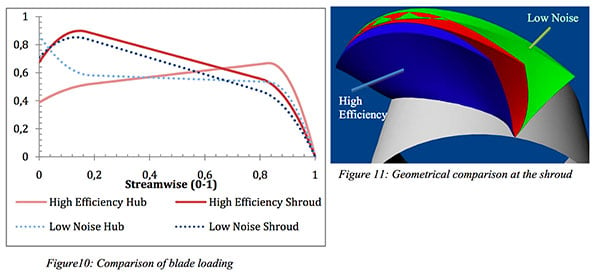In many electronic cooling applications, axial fans are coupled directly with heat sinks and this has resulted in high fan pressure rise and compact size. This type of design can only be achieved by using higher fan rpm, which may result in a substantial increase in fan noise, especially tonal noise. At the same time in many fan applications, especially in data centers, there is a need for improving fan efficiency. The requirements for noise and efficiency of axial fans pose a difficult multi-objective problem for the 3D design of axial fans.
Axial fans are conventionally designed by a (direct) approach, which starts from an assumed blade shape whose performance is evaluated by CFD codes. However, since the flow field is highly complex and 3D and there is no direct relationship between the blade geometry and flow field, the design process has to rely on the experience of designers. Experienced designers can achieve good designs by following closely what has worked in the past. However, such an approach can, inadvertently result in a reduction of the design space as the designer tends to operate within his comfort zone. Hence, using this approach will make it more difficult to achieve designs beyond previous experience (e.g higher pressure rise) or designs that meet contrasting multi-objective requirements on noise and efficiency.

An alternative method for the aerodynamic design of the fan blades is the inverse design approach, in which the blade geometry is computed for a specified distribution of blade loading. Since the blade loading is directly related to the pressure difference across the blade, the method allows the designer to directly control the 3D pressure field in the fan and have a direct control over the viscous flow field. This approach removes the need for empiricism in the design process and allows designers to directly explore a larger part of the design space.
A 3D inverse design code that has already been applied to many axial fan applications is TURBOdesign1. In this inverse design method, the blade geometry is computed for a specified distribution of blade loading, which is the meridional derivative of the tangentially mean swirl velocity and is directly related to the blade bound circulation. In this method, in addition to the blade loading the normal thickness distribution is specified and hence it is possible to ensure the structural integrity of the design. The method has already been applied to improve the aerodynamic performance of axial fans and reduce broadband noise and improve efficiency.
In this paper, the inverse design code TURBOdesign1 will be used with an automatic optimization platform TURBOdesign Optima in optimization of fan noise model based on Ffowcs-William Hawkins approach to optimize the noise and efficiency of a generic high-pressure rise axial cooling fan.



Share This Post